The following thoughts contain minor spoilers for Keep on the Shadowfell. If you don’t want to be spoiled, don’t read it. And if you’re in my gaming group then you definitely shouldn’t be reading it.
THE CHERUB STATUES
When I remixed the first part of the Chamber of Statues, I didn’t think I’d be discussing the second part of that encounter. Why? Because there was nothing seriously wrong with that section of the encounter.
… or so I thought.
I’ve been cross-posting these mini-essays on Keep of the Shadowfell to WotC’s forums, and the discussion there revealed there was actually a rather serious problem with that section of the encounter.
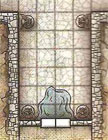 In this section of the encounter, there are four cherub statues. When triggered, the cherubs create an arcane cage to trap a victim. The cherubs then pour water into the arcane cage, which triggers a whirlpool effect that smashes the victim into the cherub statues and cause them to take damage.
In this section of the encounter, there are four cherub statues. When triggered, the cherubs create an arcane cage to trap a victim. The cherubs then pour water into the arcane cage, which triggers a whirlpool effect that smashes the victim into the cherub statues and cause them to take damage.
The key element to this encounter is the arcane cage that the statues create:
ARCANE CAGE (immediate interrupt, when a creature walks past the northern two statues; encounter)
The statues create a wall of arcane magic to enclose the area between the four statues. The wall lasts as long as at least three statues remain intact. The wall cannot be damaged and is affected only through the destruction or disabling of the cherub statues.
The key problem here is the phrase “create a wall of arcane magic to enclose the area between the four statues”. When I first read that phrase, I interpreted it as meaning that the arcane cage enclosed the entire 4×6 hallway, including the cherub statues. But then I realized that the other half of the encounter talks about the dragon statues reacting to characters outside the arcane cage attacking the cherub statues, so I concluded that the arcane cage must only enclose the 2×4 area between the cherubs.
I thought the phrasing was a little unclear, but no big deal.
Except it turned out I wasn’t the only one who had interpreted that phrase differently. In no time at all, in fact, the conversation included four mutually incompatible interpretations of what the arcane cage did and they were all legitimate interpretations of the phrase “create a wall of arcane magic to enclose the area between the four statues”:
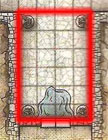
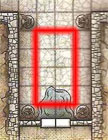
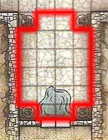
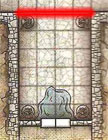
To this muddle we can also add some confusion from the phrase “when a creature walks past the northern two statues”. There seem to be two meaningful possibilities for this:
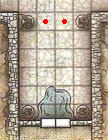
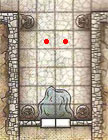
(Of course, if you go with the second possibility for the arcane cage, the answer to this question is pretty obvious — it’ll be the one that actually traps the triggering character inside the cage.)
PROBLEMS, PROBLEMS, PROBLEMS
In trying to work out how this encounter is supposed to work, we can try to narrow the possibilities down by taking two facts into consideration:
(1) Barrier effects “run along the edge of a specified number of squares”. Since each statue is entirely within one square, the statues either have to be inside the barrier or they have to be outside the barrier — they can’t be both.
(2) The dragon statues are supposed to be able to use their force shot ability against characters outside the barrier making attacks against the statues. Therefore, the statues have to be outside the barrier. (And even if this wasn’t true, you wouldn’t want a scenario where the only character who can lower the cage is the character trapped inside the cage: If they get killed by the whirlpool effect, not only are the irretrievable, but the location of the cage effectively prevents the rest of the group from reaching the end of the adventure.)
Thus we can conclude that it must be one of these two scenarios:


… except these doesn’t actually work.
First, because the cherubs have to be inside the cage (they’re pouring water into the cage and the trapped character is slammed against them for damage).
Second, because under this interpretation the guy inside the cage is effectively taken out of the game: There’s nothing they can do to escape. All they can do is hang tight, soak up the damage each round, and hope somebody gets them out. (This second problem isn’t necessarily unworkable, it’s just a questionable design choice.)
In short, the encounter doesn’t work. The cherubs have to both inside and outside the cage and, according to the rules of the game, that can’t happen.
As I see it, there are two options:
(1) Use the 2×4 option and then break the rules, basically creating an ad hoc ruling that the character inside the force cage can attack and destroy the cherubs even though they shouldn’t be able to.
(2) Redesign the encounter so that each cherub statue takes up 2 squares (and, thus, you can have them half-in and half-out of the arcane cage without breaking the rules).
FUEL ON THE FIRE
After writing up this whole analysis, I was looking through my friend’s copy of the Player’s Handbook and discovered something that only serves to deepen the confusion over what the arcane cage is supposed to be doing.
In the Quick Start Rules that came with Keep on the Shadowfell, there were three areas of effect defined: Barriers, Blasts, and Bursts. In the PHB, on the other hand, barriers no longer exist. They’ve been replaced by walls.
Here are the rules from Keep on the Shadowfell:
Barrier: A barrier runs along the edge of a specified number of squares. A barrier must cross at least one edge of the origin square.
And here are the rules from the PHB:
Wall: A wall fills a specified number of contiguous squares within range, starting from an origin square. Each square of the wall must share a side—not just a corner—with at least one other square of the wall, but a square can share no more than two sides with other squares in the wall (this limitation does not apply when stacking squares on top of each other). You can shape the wall however you like within those limitations. A solid wall, such as a wall of ice, cannot be created in occupied squares.
I have two reactions to this:
(1) Why wasn’t this fixed in the Quick Start Rules? Yet another example of sloppy editing.
(2) The encounter still doesn’t work.
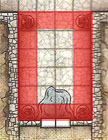
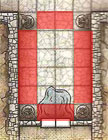
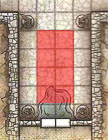
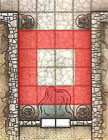
It can’t be option #1 because the arcane cage is a solid wall (otherwise you could walk through it and the trap would be pointless), and therefore it can’t be formed in the squares occupied by the cherub statues.
It can’t be option #2 because walls must fill contiguous squares and each square must share a side — not just a corner — with at least one other square of the wall.
It can’t be option #3, obviously, because then there’s no interior of the cage for someone to be trapped in.
It can’t be option #4 because the trigger for the arcane cage would either result in no one being trapped inside or would make it impossible for the wall to form (since the triggering character would be occupying one of the squares the wall has to fill).
There are two possible ways of handling this:
(1) You can use option #4, change the trigger for the trap (so that it goes off when a character enters one of the squares inside the arcane cage), and then ignore the rules so that the cherubs are somehow inside the cage (despite the fact that they’re nowhere near the inside of the cage).
(2) You can use option #2 and rewrite the effect so that it creates multiple walls. Unfortunately, it’s not clear whether or not a character inside the arcane cage can attack the cherubs. (There’s a clear rule that says you can’t move across a diagonal if one of the squares bordering the diagonal has a solid barrier in it, but I can’t find any rule that tells you whether or not you can attack through a diagonal where two solid barriers meet.)
THIS IS RIDICULOUS
Needless to say, I consider this to be ridiculous. I consider the complete inability for this encounter to work as written just further evidence that Keep on the Shadowfell was never playtested. Such a shoddily designed encounter would, frankly, be inexcusable in any professional product. But it completely baffles me that WotC evidently spent so little effort and care on the product they chose to serve as the flagship for 4th Edition.

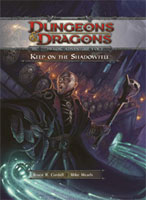











ARCHIVED HALOSCAN COMMENTS
Guest
It’s nice to see that they improved on Keep on The Shadowfell. 4e continues to be the best edition of Dungeons and Dragons in my opinion, and making touch ups like this is one of the reasons why.
In particular they made the trap much easier to understand and harder to deal with. The giant statue now has a clear radius and space it occupies, the arcane walls are now shown, etc.
They’ve also added more treasure to it, which was a bit lacking before.
Monday, May 11, 2009, 8:22:47 AM
Lgstarn
FYI WotC has fixed this encounter to a large extent now that they have released KotS for free:
http://www.wizards.com/dnd/files/H1.pdf
Saturday, May 09, 2009, 2:45:56 PM
Lgstarn
@Scott: Thanks very much – I will pour through this information in order to improve my player’s KotS experience. I already see a criticism that I agree with and has annoyed me so far: “the piecemeal dungeon assembly invites players to miss large tracts of what’s on offer.” I spent time fleshing out Balgron’s character only to have them by-pass him entirely. Doh!
@Justin: thanks for getting back to me. I see what you mean about the cheap shot trap being easy, but I only see players taking the time to spam ranged attacks on the traps if they are either really cautious and/or smart. I think my players will see that the titan/dragon statues aren’t much of a threat and just go past them without thinking more of it. Then when a player gets trapped in the cage (most likely my brash “opportunity attacks? Pah” Paladin) the dragon smashing will seem like a great idea in retrospect. However, once trapped, my players will need to decide how to approach the room in a more creative way. How should they spend their limited time: should they disable the dragon statues or go after the cherubs? Oh yeah, and don’t forget the titan!
I guess you are coming from a perspective of players who have that “respect the dungeon” attitude you mentioned in your OD&D posts. My players are no greybeards, more like peachfuzzes. I don’t think my players have enough experience ripping through traps to figure out the optimal way to go about things just yet. Unfortunately, I suspect we are the intended audience for the module, which could certainly be interpreted as the dumbing-down of DnD. Or I guess it could also be interpreted as reaching out to this newer audience. I disgress.
Re: the wall issue, I see why you might interpret it as an area wall attack for consistency’s sake. But I still think that from context it probably isn’t what is intended. I think of it as just an unfortunate and confusing word choice (which falls under the definition of poor writing). I’m thinking it is more like sentence “The adventurers *burst* into the chamber where Kalarel works to complete the ritual…” In this case we clearly wouldn’t think it was referring to a free burst area attack for the players or something. This isn’t the strongest analogy, I’m aware, but I’m just trying to say…
Let me also say that I have been following your pointers fairly closely up to this point. As a new DM, I have learned a lot from reading your reviews and improvements. Your Ninaran remix in Padraig’s manor was especially awesome. Thanks for the great site and don’t take my comments as anything other than trying to leave my thoughts for the next flummoxed KotS DM who comes through… Best wishes!
Monday, April 13, 2009, 10:32:35 PM
Justin Alexander
@Scott: For future reference, standard HTML code works.
@Lgstarn: The problem with the “cheap shot” solution to the trap isn’t that it’s easy. It’s that it’s boring. As I said, “The PCs will engage in the most boring combat imaginable: Standing where the opponent can’t possibly hurt them, the players will repetitively roll dice until they finally manage to rack up the magic number and can walk through the room unimpeded.”
It’s like playing craps without betting any money on the game. Smile
As for treating a magical wall like a magical wall… Well, I’m doing that because it’s a wall. The term “wall” is a term of art in 4th Edition. If I see an effect described as “causing fatigue”, I’m not going to assume that it’s some sort of fatigue that is unlike every other type of fatigue in the game.
Your fix for the broken encounter design seems like a good one, however.
Monday, April 13, 2009, 5:18:02 PM
Scott W.
Lgstarn: If you enjoyed this, you may also wish to check out Eleven Foot Pole (click “Homepage”–I didn’t write it, but that’s the only way I know of to embed a link here). It’s a room-by-room (and area-by-area) critique of the module, with essays on plot elements as well when they come up.
Monday, April 13, 2009, 3:56:37 PM
Lgstarn
Thanks for this useful post. It has made me see that this potentially great encounter could be destroyed by some sloppy playtesting and writing. However, I have a couple of issues with your analysis.
First and foremost, I think you are missing that the main challenge/fun of this encounter is the functioning water trap (described below) and the suspense of being cut off from everyone else while these other traps continue to harass you. Being able to walk right past the statue and not even worry about the dragons isn’t really a problem until you are struggling to get out of the cage filling with water.
For this reason, I don’t think it is necessary to get rid of the cheap shots. You’re just making the encounter more difficult with the defensive force shot – possibly as much as a level or two more difficult. If the players want to “cheap shot” the traps (aka use ranged attacks), I don’t have a problem with that for a LEVEL 2 ENCOUNTER. They are “supposed” to be around level 3 at this point in the campaign, and therefore this shouldn’t be all that difficult for them. Besides, if the dragon statues aren’t that threatening, why would anyone take the time to destroy them right away?
Same goes for the titan statue. It already gets to make one huge slice burst per turn. It will get a surprise round, and after that will continue to be something to consider because the players have to deal with the water trap. Therefore the whole problem about walking past the statue and with it not having an immediate reaction are non-issues in my eyes.
Finally, I can’t understand why you have taken the rules for a wall area attack and applied it to this magical wall. If the arcane cage were meant to be interpreted this way, I think it would have been setup as an attack like “Wall of Fog” with an attack description like “Area wall 8.” Instead, I interpret it as just a barrier in the purest sense of the word. Why would a section of a barrier take up five feet and need to be in contiguous squares? You do make a good point about the ambiguity of “enclosing the area”, but I will resolve this by making the cage be an impassible thin plane section that covers half the squares of the cherubs and encloses a 3×5 rectangle. That way, the water is coming inside from the cherubs, and you can attack the two top statues from both inside and out. Problem solved.
So I think that the way that I’ve decided to run the encounter really does not turn out to be some sort of a deal breaker for 4e or for KotS in general. Maybe this is because we all have more 4e experience at this point (almost a year after the article was written) or maybe I’m just giving it more of a chance.
I was thinking about using your illusion of safety layout, but now I’m thinking I’ll just run it as is and see how it goes. Best wishes!
Monday, April 13, 2009, 9:24:56 AM
DeadliestIdiot
As far as attacking diagonally goes, I’d say it’d could qualify as either a potential superior cover or an obstruction. It sounds like you could compare two walls meeting to an arrow slit, which would be superior cover. You could technically make an awkward melee attack of some sort through an arrow slit. So if, for example, these two barriers are such that they are marginally thinner at the top than at the bottom then an arrow slit is a reasonable approximation and calls for superior cover for the statue (considering their magical nature, I doubt this is the case). Another possibility is that the barriers get significantly thinner with hight, creating a ‘v’ shaped gap, which wouldn’t impede making attacks but would grant cover to the statue (but again I don’t think that’s the case for magical walls). Two walls could be vertical and have chipped and cracked corners creating small gaps large enough to fit a arrow through. It’d be hard to do, but the possibility exists to attack with ranged attacks and would likely involve superior cover of the attacker and a high level of concealment for the statue (again, this is probably not the case. I don’t think these barriers would have chipped and broken corners). This leaves the possibility of the walls having nice sharp corners that prevent all attacks from passing through. This is the likely scenario with magical walls which means that the victim of the trap would be unable to end the situation on his own. If the walls aren’t of the magical spell variety then the decision would be based on the characteristics of the walls themselves
In other news, the situation in which one PC blocks the wall’s activation by standing in one of it’s target squares brought me to the conclusion that this trap could very well be a party killer on it’s own. If the party is composed of at most 8 people (using the 4 wall example and assuming that the 4 walls act as if they are one wall) who walk two by two through that passageway, the trap will not be able to activate until the entire party has crossed the first wall. At this point the front pair have not reached the other wall, resulting in all the target squares being clear and the entire party being trapped inside the cage. Since they can’t attack out of the cage, their only hope is from an NPC or divine intervention (or a dm intervention limiting the trap to only last for so many rounds…which turns the trap into a huge washing machine. Actually, replacing the trap with a huge washing tub recessed into the floor with a whirlpool that activates when someone enters the tub sounds more interesting. anyone not actively involved with the trap is being entertained by a humorous situation)
[sorry for the wordy post heh. hopefully it all makes sense]
Saturday, August 09, 2008, 11:14:44 PM
longcoat000
Resurrect comment thread!
(Actually, just found your site linked from hack/ and wanted to add my two cents)
I’m not sure if you answer this in later posts, but I just found your site linked from hack/ and wanted to add my two cents.
There’s one thing I can see that would make this encounter playable, which is to make a quick edit on the text for Arcane Cage. Change, “The statues create a wall of arcane magic to enclose the area between the four statues.” to, “The statues create walls of arcane magic to enclose the area between the four statues.”
This would allow you to use option #2, which would also allow characters outside and inside of the cage to attack the statues, as well as allow all of the statues to pour water into the cage.
After that, look at what the metarule of the wall is supposed to do, namely state that there’s a barrier which prevents a character from crossing a square. A character can’t do anything meaningful in a square with a wall (which, in 4th edition, generally means engage in combat in that square), but they can still walk up next to it. They just can’t cross it.
So, you have these magical, crackling barriers thrown up between the statues, with each statue half-in and half-out of them, and water streaming from their mouths. The cage walls effectively prevent movement through the square, but (logically) don’t take up the entire square. They divide the square into two roughly 2.5′ halves (damn, but it’s wierd combining decimals and traditional measurements), and since you can’t really effectively fight on a 2.5′ ledge, WotC has said that the entire square is impassable. It makes sense from the tactical / boardgame standpoint that the rules were written in, and makes sense in it’s own internal logic, but sticks in the craw as disassociative for most people. Unfortunately, we’ll just have to suck it up and go with the flow.
The next question is, can you attack through the diagonal? I’d say yes, because a good portion of the statue is exposed to attack, but I’d give it some sort of cover bonus to it’s AC to represent the fact that it’s not completely exposed.
Wednesday, July 23, 2008, 1:32:26 PM
Leland J. Tankersley
I hear you re: players being clever. But this issue (which I think is really with the definition of the wall effect, not with this particular trap) could crop up AGAIN and AGAIN. “Clever” players may adopt a diagonal wedge formation deliberately just to increase the number of squares in which a wall cannot be formed. Which, to me, smacks of dissociation again. But my big complaint is with the apparent lack of attention to the ramifications of a definition, a personal bugaboo of mine. This smells to me of someone making a change to a rule to fix some perceived problems, and inadvertently creating a whole host of other issues through lack of consideration of the Law of Unintended Consequences. (I’m a board wargamer, and often in playtesting I’ve seen people suggest a change to a fundamental rule or mechanic to fix a particular perceived problem. Then they’ll often test the change, but ONLY IN THE CONTEXT of that original problem. There is often a sad neglect of other effects, and that really bugs me.
It is of course possible that the ramifications of this change were in fact carefully weighed and tested. But the other information in your recent writings makes me doubt that.
Monday, June 02, 2008, 9:36:34 PM
Justin Alexander
@Leland: I kinda like that aspect (of the PCs overcoming the trap by preventing the cage from forming). Specifically I like it because it requires the players to be clever. And anything that involves the players being clever always gets a big thumb’s up from. I love it when my players are clever and “thwart” me.
But it would require some way for them to know what the trap does before triggering it… and, unfortunately, there are no mechanics for that.
@merge: That is another option. However, it still runs up against the problem that all four cherub statues need to be able to pour water into the cage — and if the two northern statues are outside the cage, they can’t do that.
Another option that I missed using the wall rules from the core rulebook is to connect the four walls shown in option #2 of that section, leaving a 2×2 cage. This still doesn’t let the cherubs pour water into the cage, though, and it also results in the trigger needing to be rewritten.
So there are lots of ways in which this encounter can be fixed. Some require major rewriting of the encounter and some require minor rewriting. I think the biggest message here is: “Look carefully at this encounter and figure out what you’re going to do with it, because otherwise you have a high probability of frustrating your players when the trap either cheats or doesn’t work consistently.”
Monday, June 02, 2008, 3:40:30 PM
merge
I might be wrong, but isn’t there one more possibility using the barrier (thin line) rules? That is, the cage could be a single horizontal line (like your fourth option), but placed just past, instead of just before, the two statues (one square lower than in your fourth option). Then the trigger would be the second possibility you mention. This way, there are two statues (the top ones) to attack from the outside, and two to attack from the inside (and to pour in the water); and either the victim or his friends, or both acting together, can save the day (since the cage needs three intact statues to work. Of course, this ought to have been explained, if it’s right.
(NB: I’m not much of an RPGer, so maybe I’m missing something obvious.)
Monday, June 02, 2008, 9:33:30 AM
Tetsubo
Wow. Looks like the suckage just keeps piling up. I would laugh about this but it would be at the expense of my favorite RPG. Or what *used* to be my favorite RPG. When it *was* a RPG and not a skirmish based miniatures game.
How is this different from Talisman?
Sunday, June 01, 2008, 3:12:18 PM
Leland J. Tankersley
Heh. I like (read: am amused, but not surprised, by) the multiple problems with the cherub statue trap. And here’s another one for you if the PHB rules about walls are correct:
“A solid wall, such as a wall of ice, cannot be created in occupied squares.”
Now, presumably as you state the arcane cage is a solid wall. If so, then to defeat this trap is (potentially) trivial: One character stands in between two statues. Then the next character moves forward into the “trigger area.” But the wall sealing the “victim” in can’t be formed due to the presence of the other character. Defeating the rest of the trap is left as an exercise for the reader.
Sunday, June 01, 2008, 2:51:25 PM
Justin Alexander
Right. The statues can absolutely ready and delay actions. (At least, as far as the Quick Start Rules would lead me to believe.)
Friday, May 30, 2008, 12:56:44 PM
Leland J. Tankersley
Yeah, that’s why I suggested having them either delay acting, or ready an action, to use their ability. We’re already giving them an initiative score on which to act. Heck, if you DON’T allow them to do this, after the first round everyone in the party will know EXACTLY when the statues will attack — “It’s Mary’s turn now — remember, the statue attacks next!” I think such knowledge removes a lot of tension (read: fun) from an encounter like this. (It might be kind of cool in a sort of Pit-and-the-Pendulum situation, though… hmm.)
Friday, May 30, 2008, 9:14:33 AM
Justin Alexander
It doesn’t have a circle. I don’t have the core rulebooks yet — does that indicate which abilities can be used to make opportunity attacks?
It would be a very odd ability to be able to make opportunity attacks with, since it’s an area effect.
Friday, May 30, 2008, 1:02:09 AM
Draz
Does the statue’s Sweeping Strike power have a circle around its icon? If it does, and depending on how much “like a monster” the statue is presented, the rules might be trying to imply that it *can* make attacks of opportunity.
Not that this fixes a number of other problems with the trap’s design.
Thursday, May 29, 2008, 3:45:12 PM
Leland J. Tankersley
[continued]
[Aside: what’s with your comments preview that doesn’t tell you your comment is going to be truncated? Weak.]
Now, I don’t have a problem with their having a business model, and sticking with it. I just don’t choose to contribute. I’ll buy things I think are actually useful to me. And 4e doesn’t look like it meets that standard.
[And the whole multiple-check Challenge mechanic, with a certain number of successes before a certain number of failures? This is supposed to STREAMLINE the game? Huh? It’s just an excuse for rolling the dice LOTS of times instead of just once — it’s not like you couldn’t reduce this to a single roll. And maybe an opportunity to invent some “flavor text” on the fly. Whee.]
Thursday, May 29, 2008, 1:17:32 PM
Leland J. Tankersley
Was it playtested?
I’ll bet it was — for sufficiently small values of tested. They probably played it through once or twice, and the DM was probably fudging things a bit to make it work. I mean, when my characters are exploring a dungeon, I’m not having them all move in initiative order all the time — that bogs things down to a crawl. I describe the scene, they tell me what they will do, and at some point I deem appropriate I tell them to roll initiative. Given this layout, that appropriate point would probably be when someone moves into range of one of the trap statues.
[Aside: I have no idea if the trap rules actually specify (or even allow) this, but if I were running this I would have the trap effectively ready an action to attack the next target to move into range.]
Anyway, the trap triggered, I’d imagine the “testers” fiddled around a little bit, got through the trapped area somehow or other (probably just by, you know, standing up and moving out of range after being knocked prone), and then moved on. I’d bet good money that no one involved in testing devoted as much analysis to the trap as you did in your article. They played it once or twice, said “yeah, that’s kinda fun” and moved on.
I, too, am getting weary of the repeated statements of how they have improved, streamlined, made better, trimmed chaff, and otherwise fixed problems. But I think they feel like they _need_ to say stuff like that, to justify the new edition’s existence. And they need to justify the new edition’s existence, because that’s their business model. They need to keep putting out new product and getting people to buy it, to keep their revenue stream constant. That’s been their model, it’s been relatively successful, and they’re not going to monkey with it. The model is to put out a basic game, and then keep putting out expansions/supplements/new content that players want, or ideally NEED, to stay “competitive.” They set up what amounts to an arms race, where subscribers need to keep pumping money into the system so you have the latest and most powerful cards/figures/abilities/feats/whatever. Eventually, due to insufficient playtesting and the Law of Unintended Consequences, these incremental additions either end up breaking the back of the system they are built on, or they run out of ideas for supplements, so they have to reboot and start over. They did it with Magic, with D&D Miniatures, with 3rd edition, 3.5, and now 4e. With 4e, they’ve added the “innovation” of a monthly/whatever subscription fee for online content and tools. There’s actually some small hope that they won’t just rehash the same-old same-old with 4e thanks to this subscription model — but I doubt it. I mean, holding back formerly-core classes and races for future products? Tell me that’s not deliberately designed to get as many people as possible to buy them.
Now, I don’t have a problem with their having a business model, and sticking wi
Thursday, May 29, 2008, 1:16:28 PM